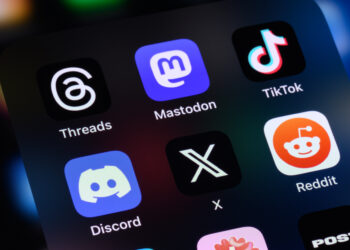
One of the exasperating things about working in publishing is that you frequently bump into people in social situations who immediately engage you on the print-vs.-digital issue. “Will there always be books?” they ask. The conversation then devolves in one of two ways: someone may love printed books, so much so that the very smell brings pleasure; and there are those who peremptorily declare that the future is coming; they have a seat in the first row of the maglev train and pity anyone with a sentimental attachment to print, whether for books, newspapers, or anything else. Publishing is one of those fields, like politics, where everybody is an expert, so we have to pit our noses against those of the lover of print or discourse on the market cap of disruptive tech companies (my favorite: “Google is just getting started”). Print and digital: it’s supposed to be either/or. You are invited to declare which side you are on and fight to the death. Soon to be a TV series: Game of Books, set in the mythical kingdom of Suburbia and starring Jerry Mathers as the Beaver (“Literature is coming!”).
While I doubt there is a publishing professional anywhere who has not pondered whether print will always be with us, the point for managing an enterprise is not to predict the last day of print but to craft a strategy that mediates appropriately between the two until the End of Days. This means acknowledging the huge differences from one publishing segment to another (what do medical textbooks have in common with apps for cooking and recipes?) and also that the rate of migration from our aromatic print publications to our clinically sterile digital formats differs widely for these segments. Financial publishing, for example, except for a few consumer magazines and the wheezing Wall Street Journal, is wholly a digital game, dominated by the likes of Thomson Reuters and, of course, Bloomberg. (If you have never seen the Bloomberg service, you have missed out on one of the wonders of the publishing world.) But children’s books? Putting aside the problem of having your adorable little kid drop an iPad into the bathtub, parents continue to like the experience of turning pages with their offspring, and the persistent sales of children’s books are proof positive.
Even within academic publishing there are multiple segments, each of which marches to its own drummer. STM journals are almost entirely digital by now, of course, but not so scholarly monographs, which still recognize over 80 percent of their sales from print formats. Particularly interesting are those publications that are anchored in one medium or the other. PLOS ONE, for example, does not and could not have a print extension and still call itself a pure open access (OA) publisher for the simple reason that the variable costs associated with print would be unsupportable in a purely OA environment. But art books? Display technology continues to lag behind high-quality color printing. We may have to wait a while before removing our treasured art books from the coffee table.
A better way to manage a publishing enterprise is to think of print’s half-life. That is, how long will it take for half of the current print production in a particular segment to become digital? The half-life of anything is a moving target: today’s half-life is tomorrow’s starting point. So STM journals, for example, are already well over half in digital form, but the half-life question is how long will it take for one-half of the remaining print publications to become digital. In some segments this is a very big question–college textbooks, for example, where the print supply chain continues to exercise significant influence on what books get published, how many copies they sell, and how often they get revised.
Thinking about the migration to digital formats often gets stuck on production issues and misses the larger point that when the medium changes, the ecosystem often changes as well. In trade books the shift from print to digital is not merely a matter of ebooks but the collapse of the physical bookstore. In STM journals the shift to digital has inspired an entirely new outlook on the part of funding agencies, which now may mandate OA publishing, whether of the Green or Gold variety. That’s a much bigger issue than whether or not you have an XML workflow down pat. And when you get that XML workflow, what are you going to do with it? Do you believe your business can flourish if you sell journals by the article or books by the chapter? Does that even remotely support the size of the investment? For an organization contemplating the role of print, the first-order questions are not about products or the organization but about the broader economic environment in which the organization operates. Interestingly, the journals world thus far has mostly been able to ignore the ecosystem-changing aspects of digital media despite the disruptions nibbling at the margins. This is because the institutional markets (meaning libraries) remain the largest customer segment for journals, whether in print or digital form. Libraries are about preservation: of texts, of standards, and of ecosystems. A “disruptive library” is a contradiction in terms.
A half-life strategy quickly brings us to realize that if some people are intent on sticking with print, there must be a reason for that, and those people can be taxed for that preference. This is why advertisers pay so much to appear in the print edition of the New York Times–they could be anywhere, but they feel that they must be here. We are happy to accommodate you, established print publishers say, but this is what it will cost you for that scarce resource. A book publisher that already has a digital product line in place has a compelling invitation to raise prices for print books. I just completed an assessment of a university press and concluded that the prices of its print volumes could be increased by 30%. Trade publishers have caught onto this, too: the prices of trade paperbacks in bookstores appear to have risen from $10 to about $15 in just a few years. More profit for the publishers and, not incidentally, for the bookstores, who could use the margin. If you want print, you will have to pay for it.
Sometimes the economic interest in eliminating print is not immediately measured in dollars and cents. Large journals publishers, for example, routinely attempt to nudge their society clients to drop their print editions. The ostensible reason for this is to reduce the cost of maintaining print publication now that so few people read in print. Not so fast, I think. Those print readers tend to be among the most loyal to their societies. The larger publishers, which act as service providers, have an interest in migrating loyalty to their large aggregations away from individual journals and societies (even as OA advocates attempt to migrate loyalty away from journals to articles). This is not to suggest that there is a conspiracy, but publishers act in their own interest. Trust but verify.
A half-life strategy thus will encompass the following at a minimum:
- A plan for price and margin-optimization for print formats.
- A disinvestment plan that identifies the milestones that will trigger cutbacks in overhead. It’s always best to have this in place well beforehand, as downsizing is hard to accomplish in the best of circumstances.
- Correspondingly, a target for when the sale of assets may be undertaken (there are in fact buyers actively seeking rights for print properties).
- Different compensation schemes for the print and digital units. This is hard for an organization to come to grips with, but the incentives for managing a declining business are inherently different from those for a growth business.
- A commitment not to preserve a market by handicapping services geared to new markets. This is the “don’t cannibalize the old with the new” problem. Organizations that make this mistake serve up a nice rump roast for the competition.
- An economic analysis of all the players and components of the ecosystem. Print publishers sometimes seem to think that printers will always be there, but they could disappear before consumer demand for print dries up. Every link in the value chain must be profitable for the ecosystem to endure.
Above all, don’t build business plans on anecdotes. It doesn’t matter whether you like the smell of print or not or if you feel very cool reading articles on an iPad while sipping a latte at Starbucks. The question is the trend lines for the ecosystem as a whole, and to get at that information you have to get to the data.
Discussion
14 Thoughts on "The Half-life of Print"
Back in 2000, I published a study of “Pediatrics” that used all sorts of sophisticated math and disruption theory to predict when that journal might be able to go online entirely. However, I missed at least two major impediments completely:
1. The print advertising markets (display and classified) would slow this migration down or block it entirely, because no organization is going to give up marginal revenue just for a media choice.
2. The member value equation, which meant that the #1 member value item — receiving the print journal at home or in the office — had to remain tangible, even if 100% of members also had activated their online access.
This is a great post, as it underscores that it’s both foolish to believe that print/digital is a zero-sum game and that the reasons to shed print are complex, difficult to wrangle, and shaped mostly be economic factors that require a lot of analysis. We’re also seeing young people with a preference for print in certain settings (studying). Most of all, if we’re truly “multimedia” or “media agnostic” or whatever, print fits as another media people generally like.
Kent:
ACS found the same to be true. Membership and readership liked print and wanted to continue receiving their journal.
Advertisers, simply put, will not pay for on line ads at the same rate as print ads.
As a mentor once said: All we are talking about here is money.
All I can is Yes, exactly: “the point for managing an enterprise is not to predict the last day of print but to craft a strategy that mediates appropriately between the two….”
But I’m wondering if the advice about “if you want the print you have to pay for it” can be applied to textbooks, where price is already a hot-button issue that has made publishing companies an object of vitriol among many, many students, and yet for students, print remains the favorite medium of delivery (and I think there are solid cognitive reasons for that). The high prices is one reason students would rather share, buy used, or pirate textbooks and print them out than buy them. Students have effectively responded to the publisher’s price points by flat out refusing to purchase books for their courses. And they haven’t been rushing to cheaper digital books as an alternative either.
However, your sense that different markets require different approaches is what makes this post such a stand out. It’s not just at social get togethers that I, a textbook author and therefore the perfect candidate for these interminable chats, am subjected to the tired old “print is dead versus I love the smell of books” discussion. it’s also on countless blogs and Web postings of all kinds. So what a pleasure to read a discussion that considers the different market segments and where and how they might or might not successfully make the transition from print to digital.
And yes to figure out what to do for the future, it’s not the tedious party musings about print versus digital that have value, it’s the collection of data that will tell the story, which raises another issue I think you and others have addressed, and I hope will address again because it is so complex: what data, how is it collected, above all, how is it interpreted, and by whom.
This is good stuff, especially how hard it is to plan for terminating a major product. But I am not clear on just how the half life plays in here. First, is the idea to predict the half life or wait for it to happen? Second, how does the half life of print products in one’s sector determine the decision to terminate one’s specific print products? It also seems that defining a sector and getting the half life data might be challenges. While there clearly are sectors they might not be countable.
My reply to the “Will there always be books” question is: – well, just as books weren’t killed by radio, and then radio wasn’t killed by cinema (or was it the other way around?) and then neither was killed by TV and that lives on despite the internet – so, yes, there will always be books, and printed ones too (see also the come-back of vinyl). The challenge is therefore ‘just’ one of management, cost and ROI.
Couple of things I liked in the post: the idea of selling print rights to someone else (so they have the headache instead), I guess POD is another version of doing that; the importance of print for the ‘immediate audience’ a.k.a. society members – roughly 50% of our print demand is from our equivalents and this demand is proving very resilient, unlike demand from the wider market which is shrinking quite fast. The flipside of this is the realisation that if you don’t have an immediate audience in the form of society members or equivalent, then demand for print may fall to a point where the ROI disappears.
Finally, I’m not sure what to make of Joe’s assertion that 80% of monograph income is still from print – this is almost the opposite of our situation – we’re at 85:15 digital:print and I can’t believe that we’re such an outlier!
Toby Green
OECD Publishing
One reason you’re such an outlier, Toby (and you are!) is due to the extent to which you’ve developed useful, compelling, and in some cases indispensable digital functionality around and in your publications at OECD. Those digital aspects have unquestionable value to _your customers_. This is rapidly becoming the case with college textbooks as well, but that is just emerging due to the long editorial/production/adoption cycles in that environment. There is about to be a precipitous shift from print-preferred to digital-preferred in the higher ed sphere, and to some extent the secondary ed sphere. But monographs? Not so much, because for the most part (not for all of them, of course) the shift to digital is more a matter of convenience, people gradually becoming more reliant on their ereaders and tablets and phones and coming to regard the physical products as more burdensome. Novels and kids books? Those are about pleasure, and the pleasures of print will persist there–though alongside digital, because frankly there are more novels read as ebooks than any other type of publishing. Both/and, not either/or.
I teach writing, and my students engage in discussing and living out this issue. The school is involved in a kind of transition toward textbooks on e-readers rather than in print. This term I have one class that is for e-books and one class that uses printed textbooks (still). So far, the range of talk and action indicates indifference from some learners toward e-books and antipathy from many toward taking printed textbooks away. The comments in favor of print can be sentimental about simply enjoying the act of reading with a traditional book and such. But the comments are often practical and specific: what if the electronic textbook becomes unavailable when I want to refer to it in the future? what happens when electronic features such as highlighting and note-taking don’t work? what do I do when I need (literal) space in the textbook for diagramming, drafting, or simply responding to exercises? I rarely receive comments in favor of e-books unless it’s from those who don’t really care one way or the other. And I have been surprised by the emphatic comments made in favor of printed books and against the electronic ones. Maybe this is all the birth pangs of transition. But for now this is how the main constituency I serve is responding and dealing with the imposition or simply the option of electronic textbooks.


